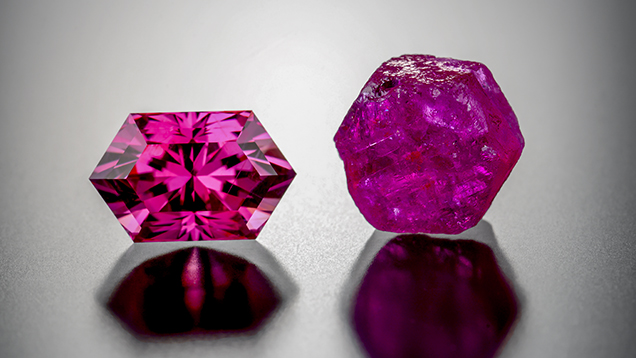Rare Intense Purplish Pink Montana Sapphire

Recently the Carlsbad laboratory received an intensely saturated purplish pink faceted sapphire for identification and origin report (figure 1). The faceted stone weighed 3.93 ct with measurements of 10.93 × 6.58 × 6.61 mm and had a hexagonal modified mixed-cut style. Standard gemological testing revealed a refractive index of 1.761 to 1.769, and a hydrostatic specific gravity of 3.99, both consistent with corundum. The stone fluoresced medium red to long-wave UV and weak red to short-wave UV.

Microscopic examination showed angular and oval shaped reflective films, short needles, intact crystals with decrepitation halos and fluid films (figure 2). Also present were dense bands of rutile silk interspersed with finer bands of silk (figure 3). These internal characteristics are typical for sapphires from secondary Montana deposits including Rock Creek, Missouri River, and Dry Cottonwood Creek (E.J. Gübelin and J.I. Koivula, Photoatlas of Inclusions in Gemstones, Vol. 3, Opinio Publishers, Basel, Switzerland, 2008, p. 226). The decrepitation halos, the unaltered bands of hexagonal rutile silk, and intact crystals showed no indications of heat treatment. Notably, decrepitation halos are not indicative of heat treatment for sapphires originating from magmatic environments, including Montana sapphires (Winter 2018 Lab Notes, pp. 434–435).

Advanced testing with laser ablation–inductively coupled plasma–mass spectrometry (LA-ICP-MS) was used to obtain the stone’s trace element chemistry. The results indicated ranges of Mg (23.8–29.6 ppma), Ti (20.4–22.9 ppma), V (1.75–1.86 ppma), Cr (89.8–108 ppma), Fe (813–864 ppma), and Ga (10.9–11.6 ppma). The LA-ICP-MS trace element chemistry was consistent with Montana sapphires when compared to known sample material from the GIA colored stone reference collection. Chemical profiles for pink and purple sapphires as well as rubies from Montana have been documented (see Winter 2018 Lab Notes, pp. 434–435 and Summer 2019 Gem News International, pp. 286–288).
Sapphires from Montana are separated into two groups based on the geology of the deposit. Sapphires from secondary deposits include Rock Creek, Dry Cottonwood Creek, and Missouri River, while the only primary deposit is at Yogo Gulch. The inclusion features in this purplish pink sapphire are consistent with stones from Montana’s secondary deposits. This sapphire is reported to be from the Rock Creek deposit. While Rock Creek is historically the most productive deposit in Montana in terms of overall volume of sapphires recovered, stones from this deposit continue to increase in popularity due to their unique colors and excellent clarity (J.C. Zwaan et al., “The origin of Montana’s sapphires,” Winter 2015 G&G, pp. 370–391). Typically, Montana sapphires are less than 2 carats in size. This lends to the rarity and exceptional qualities of this large 3.93 ct intense purplish pink unheated sapphire.



